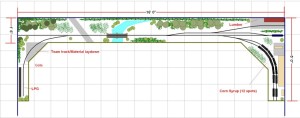
Reality based layout design? By that I mean let’s design for what our lifestyles are ‘actually’ like not what we hope or think they will be. For any of us that have even a passing interest in operations, the driving factor in layout design comes down to the length of an operating session. How much layout do we need to give us the operating session we want? Given that the session length is the what pushes everything on the design front, we need to get a solid grip on it. How long is our session likely to last? My experience has been that most people will have sessions that are far shorter than they expect but also run more frequently (which is a good thing). It’s also critical that you get a realistic handle on whether you will be operating alone or be in a situation where you frequently have guest operators. You’ll quickly find that it is a lot easier to grab a throttle on a whim and have a short solo session after dinner than it is to round up even a small crew for a ‘formal’ session. That means those solo, short sessions become the norm. That’s a good thing. It means you’re in the game, you’re engaged in the hobby.
Let’s design towards the rule not the exception, the norm not the once every two years. For the majority of us, the reality is that ninety per cent of the time we’ll probably be operating the layout by ourselves. Sure, three hour operating sessions sound good on paper but again, let’s talk real world. In terms of session length we’ll have probably “had enough” after about forty five minutes of running. However, we’ll also likely be ready for a repeat of more of the same sometime in the next day or so. In other words for most of us, three, four, or five operating sessions a week that are anywhere from ten to forty five minutes long will be the norm. Let’s design and build our layouts to that end, not the fantasy world of three hour, multi-operator sessions.
If those solo, forty five minute sessions are the norm, let’s design our layout for that and no more. Include just enough industries to satisfy the likely ‘everyday’ and then use the remaining space for scenery. Maximizing ‘greenery’ square footage should be an overriding factor in layout design, not squeezing in ‘more stuff’. It’s having those ample scenery footprints separating ‘urban zones’ that creates a sense of distance and the needed geographical stamp that tells us where we are. I can’t emphasize it enough. During the design process there should be a constant, almost palpable sense of the green scenery expanses constantly pushing industries off the layout edge and out of the design.
The challenge becomes how do we create a design where fifty or sixty percent of the layout surface area is devoid of structures and still create a realistic operating scenario that lasts forty five minutes to an hour? A simple load for empty swap, operated prototypically, will probably only take about ten or fifteen minutes. That means, we’ll need at least four industries to hit our one hour target. However, switching every industry every session isn’t realistic. The prototype doesn’t do that so we’d actually need more than four. Now we’re up to six or seven. For a typical switching layout that’s just too much “stuff” crowding the landscape. It doesn’t allow enough room for scenery. We’re back to square one meaning a typical looking model railroad as opposed to what we want, a model of a railroad.
There is an easy out. The key is to pick one industry that requires a lot of car spots. Doing so gives you the equivalent of many industries in just a few square feet. Commonly found, highly realistic, real world examples are corn syrup facilities, food service industries, and logistic warehouses. Design in one, high car spot industry, and then you just need two or three other industries and you’re good to go. Also, remember that carriers often use any section of a spur next to a parking lot to serve as a team track and that gives you yet another industry. If our one high car spot, anchor industry by itself will give us our target operating session length, that takes the pressure out of the design process. Now we have the luxury of just needing two or three one spot industries to provide variety.
In the above design, if operated prototypically, the corn syrup facility alone would probably take ninety minutes to switch. (Reference Jim Lincolns article on the subject in Model Railroad Planning 2010). That single design decision, the decision of industry selection, is the home run we need. By choosing that particular facility, the op. session length goal has been met before we even start, the rest is gravy. The above plan would be inexpensive, easy to build, and operationally satisfying. It’s attainable to anybody from young student to somebody in a retirement community. The essence of a successful design isn’t about shoehorning in ever increasing piles of crap that won’t ever be utilized. It’s about coming up with a balanced creation where every element has a purpose that, when combined, results in a layout that fits our real life circumstances.